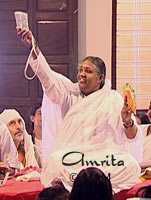28 August 2007 — Amritapuri

When Amma came to the temple for Meditation Day on Tuesday, a small purse and hand-fan were waiting for her on her peetham. After sitting down, Amma placed the purse’s strap over her shoulder and began fanning herself, beaming a smile as if she were modelling some of the most glamorous apparel in the world. Amma then showed everyone how the blade of the fan was made from chocolate-bar wrappers and how the purse had been woven from strips of disregarded plastic. Amma then asked the people who’d made the items to stand up. Two ashram residents rose to their feet—one from India and one from the West.
amma holding a plastic fan
“Amma is very pleased by these children’s efforts to create wealth from waste,” Amma said. “You make think it is only a small gesture, but through this the hearts of the individuals blossom and then others are inspired to follow. This can lead to significant changes in society.”
Amma then went on to explain how plastic, although cheap, is non-biodegradable. “This is one way to fight this problem,” Amma said.
Amma said that in general she was very pleased with how her children from the West are taking to heart and putting into practice her teachings of the importance of re-establishing the harmony between man and nature. Amma went on to give the example of how many devotees in America have formed car-pool groups in order to reduce the amount of cars they use to get back and forth from work. “In this way, they reduce the amount of pollution emitted into the atmosphere, reduce the money they spend on gas, reduce the use of gas, and reduce traffic,” Amma said.
One of the main weavers was an ashram resident from America named Meenamba. She says she was inspired to start the weaving project after one of Amma’s programs in Mumbai. When the program ended, local children came and began culling through the trash for hard-plastic bottles and clean paper. She learned that the children get about 50 rupees for each a bag they fill with plastic bottles and a few rupees per kilogram for paper. But the soft plastic (candy wrappers, etc.) wasn’t recycled in any way—just burned. Meenamba wanted to come up with a way that the poor trash-pickers could earn more money as well as help the environment. Eventually the idea of using the soft plastic as a weaving material dawned to her.

When Meenamba returned to Amritapuri, she started collecting various types of disregarded plastic—plastic bags, chocolate wrappers, plastic twine, laundry-soap packets, old banners advertising Ashram programs. She then sanitized all the materials by washing it and soaking it in EM (Effective Micro-organisms). When that was finished, all that was left to do was to cut it into strips and weave it. To do this, she learned a number of weaving techniques, including methods from Kerala, Tamil Nadu, Japan and Bavaria.
So far Meenamba and the others have made an assortment of items, including a pair of sandals and an asana for Amma. Some of the other things they have made include cell-phone cases and carry bags.
—Kannadi
